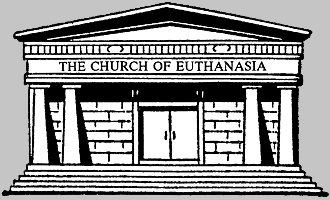
|
| Church of Euthanasia |
The One Commandment: "Thou shalt not procreate" The Four Pillars: suicide · abortion cannibalism · sodomy |
|
SAVE THE PLANET KILL YOURSELF |
|
news ·
resources ·
e-sermons ·
snuff it ·
family album music · video · catalog · faq · press · links · contact |
Interview with Chris KordaBy Thilo Schneider Please introduce yourself. Greetings. We are not of this planet. Your last Perlon album "Apologize To The Future" was dedicated to central issues like climate change, anti-nationalism and economic inequality - issues you have been trying to raise awareness for since the 90s with provocative actions and dadaistic slogans. Well, public awareness of the many man-made problems is now given, solutions not in sight. How do you now reflect on your early actionist days and what has fundamentally changed since then? You very likely won the sperm and egg lottery, and were consequently awarded a front-row seat at life’s banquet. If civilization showered you with gifts, including literacy and numeracy, you have a moral obligation to give back. Personal transformation is a good start but it won’t be enough. We’ve wasted too much time, and burned too much carbon, and now only institutions have sufficient power to change human behavior quickly enough to matter. Go forth and infiltrate our institutions. We can still become a long-lived species, but only if we agree that’s the goal and act accordingly. What actually happened to the Church Of Euthanasia, your movement critical of population growth? Many of your actions back then are difficult to imagine in today's political climate. The Church of Euthanasia is bigger than ever and its relevance has only increased since its founding in 1992. It continues to gain members rapidly throughout Europe, and particularly in France. Its tactics have certainly changed—unsurprisingly after thirty years—but its core ideology remains the same. The Church still advocates voluntary population reduction, and still requires its members to take a lifetime vow of non-procreation. By eliminating potentially infinite trees of descendants, Church members embody limits to growth and expiate their environmental sins. Removing yourself from the gene pool is the ultimate carbon offset. In recent years, there has been much discussion about the repoliticisation of club music and its spaces, often from the perspective of identity. How do you look at this discourse? The widespread use of disassociative drugs suggests increasing indifference and nihilism. Anesthesia is unlikely to fuel political engagement. It’s no coincidence that the reign of club culture overlaps precisely with the reign of neoliberalism. Structured dancing, which is inherently collective, has largely been displaced by individualistic dancing (exemplified by Billy Idol’s “Dancing With Myself”) and this is symptomatic of declining social cohesion. It’s understandable that people want to escape from reality, since the future is increasingly bleak, but corporations will continue to exploit such passivity. As long as electronic music remains focused on partying, its revolutionary potential is nonexistent. Hedonism is not historically associated with effective political movements. Climate change won’t be solved by melting your liver. I expect irrational exuberance from yeast in a bottle, but human beings are supposedly smarter. Between 2004 and 2019, you released no music and largely retired from the music business, instead writing software for 3D printers, among other things. What motivated you to write music and perform live again after 15 years off? I took a break from electronic dance music partly because of the bankruptcies of EFA and Gigolo Records, but also because my homegrown polymeter sequencer had become obsolete and was limiting my creativity. During this period I continued to compose, perform, and release music. I released phase music compositions including “Al Fasawz” (2003), “I'll Just Die If I Don't Get This Recipe” (2005), and “Plasmagon” (2009). I also taught myself jazz piano and performed in a jazz trio (The Enronettes). In 2014 I developed a meta-instrument called ChordEase that facilitates improvising to chord changes, and used it in another jazz band (Robogonzi). That band was named after my longtime music teacher, tenor saxophonist Jerry Bergonzi, because ChordEase automated his harmonic systems. Meanwhile I gradually acquired the necessary engineering skills to redevelop my Polymeter MIDI Sequencer for modern computers. My album “Akoko Ajeji” evolved alongside this redevelopment, starting in 2018. My redeveloped sequencer enabled new composition techniques which were motivational and essential to my post-2019 releases. Your music is usually composed in complex polymeters, for which you have developed a special software. Can you explain this particular musical principle and your fascination with it to us musical non-experts? Space limitations prevent me from explaining this principle, but I invite you to research it on the website of the Polymeter MIDI Sequencer, which you can find via chriskorda.com. |